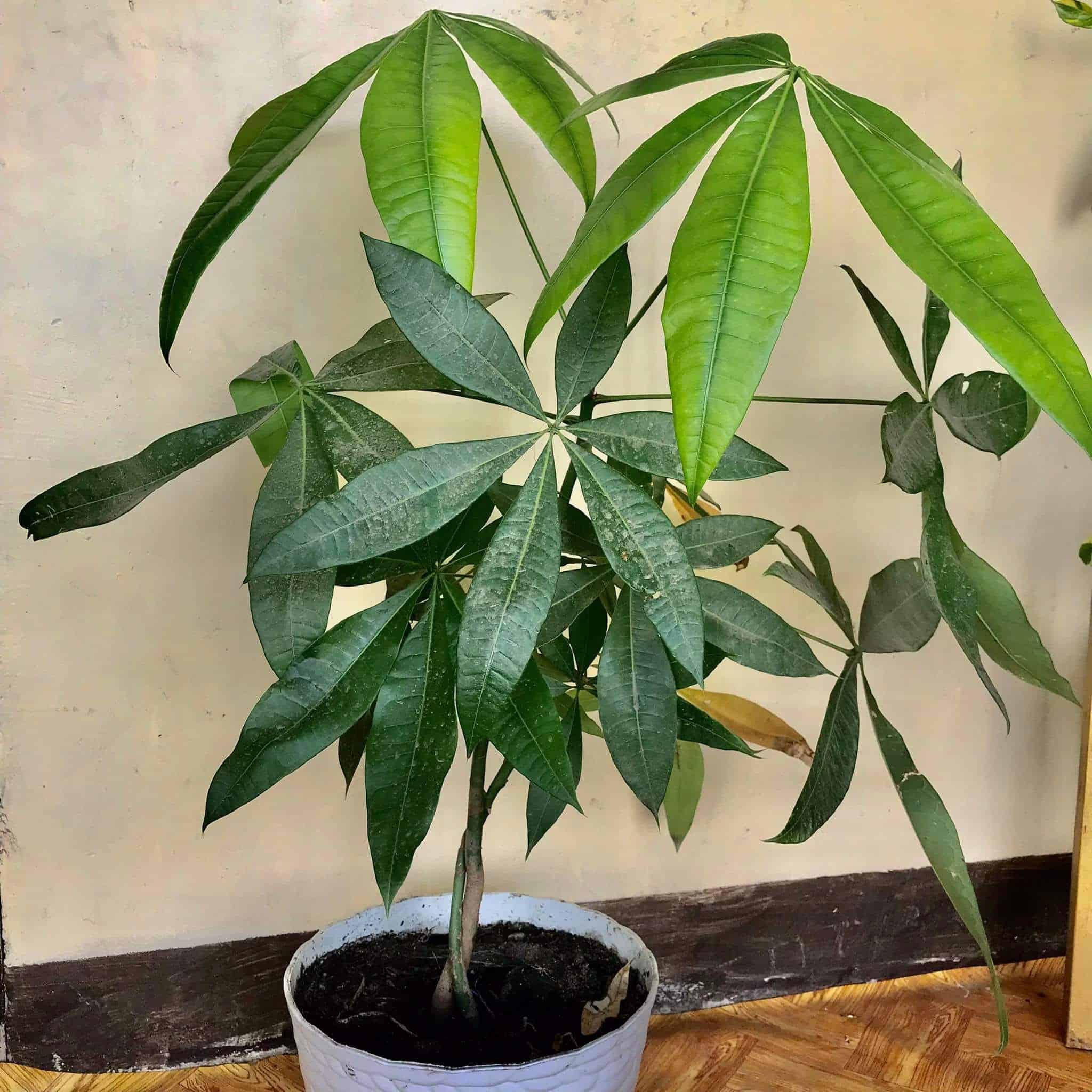The Money tree is famous for its Feng Shui value of bringing wealth and prosperity when grown in your home.
The braided stem and broad green leaves of the Money tree are easy to look after but have a particular soil requirement, i.e., light, airy, moist, and humus-rich.
By the end of this article, you will have a clear picture of the type of soil Money trees require.
Table of Contents Show
What Kind of Soil do You Use for the Money Tree?
Porous soil that holds enough water is best for a Money tree.
High moisture in the soil causes several plant problems obstructing its growth and physiological activities, and so does dense soil.
Accordingly, the following properties must be considered before you buy or DIY any potting soil for Money Tree.
1. Drainage and Moisture Retention
The Money tree enjoys moist soil but should not be too wet. Excessive moisture in the root zone leads to root rot and yellowing of the leaves.
Potting soil or mix should be such that the pores hold enough water, draining the surplus. This way root gets enough moisture and is still not soggy.
Unlike clay, inorganic matters like perlite and vermiculite expand soil pore space, promoting aeration.
Coco coir would be a savior in the case of dense soil. It improves the soil texture and never lets the root dry out, holding ample water.
Further, you can add sand or peat to ease soil compaction.
2. Nutrient and Soil pH
Money plants are less demanding when it comes to nutrient requirements.
A balanced fertilizer with an equal nitrogen, phosphorous, and potassium ratio persuades the plant’s optimal health. The ideal pH for a Money tree is 6-7.5.
The plant easily absorbs most nutrients in this pH range.
While Money trees respond well in neutral to slightly alkaline soil, the availability of iron and magnesium might be doubtful in the long run.

In addition, micronutrients like iron, calcium, magnesium, sulfur, etc., are thoroughly essential.
Consider supplying the soil with the same or repotting the plant in a nutrient-rich mix.
You might want to use synthetic fertilizer for its promising impact. However, it might end up fluctuating the soil pH value.
Moreover, organic matter like compost facilitates microbial growth.
Signs that You are Using the Wrong Soil Mix for Money tree
When planted in an improper potting mixture, your Money tree may show the following signs of distress.
- Leaves appearing droopy and faded
- Soil compaction
- Darker roots and browning leaves
- Mushy lower stem
- Stagnant water
- Braided trunks losing color
Leaf curling in Money tree could be a potential signal for the wrong soil mix, backed by overwatering, overfertilization, and low humidity.
If you do not look into the problem in time, the Money tree can eventually die.
Best Commercial Potting Soil for Money Tree
Some potting soil is formulated explicitly for Money trees, and some broad-range ones are readily available in the market.
With so much to choose from, let me make it easy by compiling the best commercial potting soil for your Money tree.
| Name | Benefit | Drawback |
|---|---|---|
| Birch seed Money Tree Soil Blend | Sandy peat based mix for appropriate drainage. Added lime and wormcasting for proper growth. | 2QT pack fails to fill large-size pot. |
| Perfect Plant Money Tree Potting Soil | Coco coir retains enough moisture. Lightweight formula prevents suffocating roots. | Lack organic fertilizers |
| Money Tree Potting soil by Gardenera | Promotes soil drainage and aeration. Rich organic nutrients provided by worm casting. | High price point based on quantity |
| Miracle-Gro Succulent Mix | Fast-draining reciepe Includes slow releasing fertilizer | Doesn't specifically focus on Money tree. Too light, mix with stand potting soil |
| Rio Hamza Money Tree Soil | Organic formula Ideal drainage and nutrient rich | Not resealable On pricey end |
Apart from these, you may experiment with making your soil mix, keeping drainage, aeration, and growing conditions in mind.
Make Your Own Potting Soil for Money Tree
While some store-bought soil mix may be highly porous, they may lack structural support and indispensable nutrients.
Making your soil mix is a cheaper option that allows you to alter the ratio of components.
Therefore, I have mentioned some tried and tested potting mix ideas using the component below that you can benefit from.
| Materials | Properties |
|---|---|
| Sphagnum Peat Moss | 1. Aid microbial growth and ensures stuructural support. 2. Retains enough moisture and prevents soil compaction. |
| Perlite | 1. Improved drainage and porosity 2. Helps in root establishment and growth specially while repotting |
| Coco coir | 1. Good aeration and drainage 2. Better water holding capacity. |
| Vermiculite | 1. Natural soil conditioner 2. Doesn't decompose quickly |
| Vermicompost | 1. Provides proper nutrition. 2. Supports microbial growth |
DIY 1:
- 30% peat moss
- 30% sand
- 30% perlite
- 10% vermicompost
The addition of vermicompost is vital to provide immediate nutrients during repotting or propagation of the plant.
DIY 2:
- 2-part succulent mix
- 1 part peat moss (with vermicompost)
Factory-made succulent mixes are enriched with nutrients. Adding vermicompost to the recipe is optional.
DIY 3:
Mix equal parts of coconut coir, perlite, and compost.
Adding compost is mandatory in this recipe as non of the former component possess nutritional value.
Since vermiculite has a similar attribute as perlite, you could interchange them.
Finally…
There is no stone-carved rule about a particular soil mix for a Money tree. The composition can always be mixed and matched.
But for a Money tree to do well with proper soil, look after the external factors like environment, humidity, and lighting.


